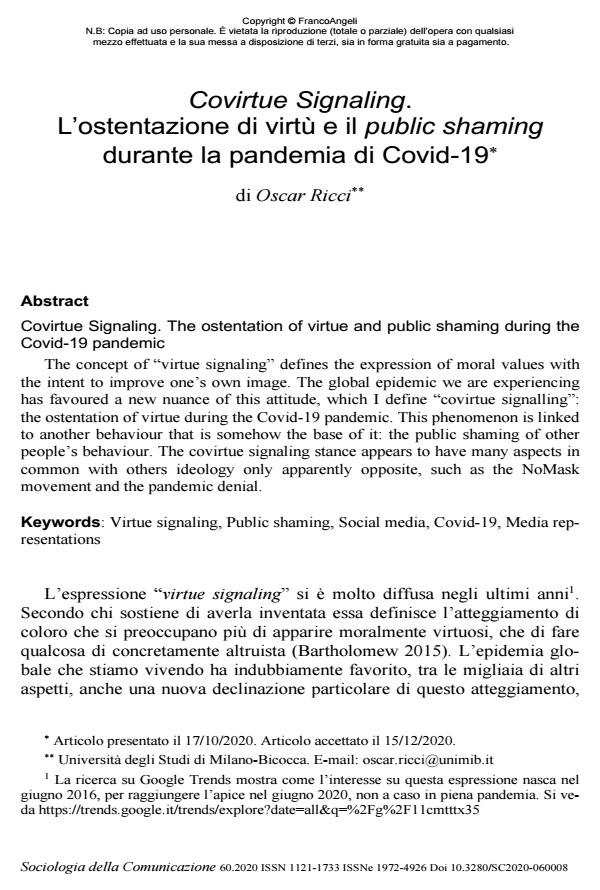Covirtue Signaling. L’ostentazione di virtù e il public shaming durante la pandemia di Covid-19
Titolo Rivista SOCIOLOGIA DELLA COMUNICAZIONE
Autori/Curatori Oscar Ricci
Anno di pubblicazione 2021 Fascicolo 2020/60 Lingua Italiano
Numero pagine 13 P. 82-94 Dimensione file 658 KB
DOI 10.3280/SC2020-060008
Il DOI è il codice a barre della proprietà intellettuale: per saperne di più
clicca qui
Qui sotto puoi vedere in anteprima la prima pagina di questo articolo.
Se questo articolo ti interessa, lo puoi acquistare (e scaricare in formato pdf) seguendo le facili indicazioni per acquistare il download credit. Acquista Download Credits per scaricare questo Articolo in formato PDF

FrancoAngeli è membro della Publishers International Linking Association, Inc (PILA)associazione indipendente e non profit per facilitare (attraverso i servizi tecnologici implementati da CrossRef.org) l’accesso degli studiosi ai contenuti digitali nelle pubblicazioni professionali e scientifiche
;
Keywords:Virtue signaling, Public shaming, Social media, Covid-19, Media representations
- Barbera P., Vaccari C., Valeriani A. (2017), Social Media, Personalisation of News Reporting, and Media Systems’ Polarisation in Europe, in Barisione M., Michailidou A. (eds.) Social Media and European Politics. Palgrave Studies in European Political Sociology. Palgrave Macmillan, London.
- Barret R., Brown P. (2008), Stigma in the Time of Influenza: Social and Institutional Responses to Pandemic Emergencies, in «The Journal of Infectious Diseases», 197, pp. 34-37.
- Bartholomew J. (2015), I Invented “Virtue Signaling” Now It’s Taking Over the World, in «The Spectator», October 10.
- Boltanski L. (1993), La Souffrance à distance, Paris, Métailié; trad. it (2000) Lo spettacolo del dolore. Morale umanitaria, media e politica, Cortina, Milano.
- Boni F. (2020), Frammenti di un discorso virale. Le cornici del coronavirus, in «Mediascapes», 15, pp. 3-12.
- Brown L., Macintyre K., Trujillo L. (2003), Interventions to reduce HIV/AIDS stigma: what have we learned?, in «Aids Education and Prevention», 15, 1, pp. 49-69.
- Casiano I. C. (2020), Reframe the Shame: Accusing Others of “Quarantine Bragging” Downplays Resilience, testo disponibile in: -- https://psychcentral.com/blog/accusing-others-of-quarantine-bragging-downplays-resilience/
- Cato S., Iida T., Ishida K., Ito A., McElwain K.M., Shoji M. (2020), Social distancing as a public good under the COVID-19 pandemic, in «Public Health», Pre proof, Onlinefirst.
- Dal Lago A. (1999), Non-persone. L’esclusione dei migranti in una società globale, Feltrinelli, Milano.
- Douglas D. (2016), Doxing: a conceptual analysis, in «Ethics and Information Technology», 18, pp. 199-210.
- Douglas M. (1966), Purity and Danger. An Analysis of Concepts of Pollution and Taboo, Harmondsworth, Penguin; trad. It. (1975) Purezza e pericolo. Un’analisi dei concetti di contaminazione e tabù, Il Mulino, Bologna.
- Douglas M. (1992), Risk and Blame, London-New York, Routledge; trad. it. (1996) Rischio e colpa, Il Mulino, Bologna.
- Dunsby R., Howens L. (2018), The NEW adventures of the digital vigilante! Facebook users’ views on online naming and shaming, in «Australian and New Zealand Journal of Criminology», 52, 1, pp. 41-59.
- Esmoris M., Hijós N. (2020), Exposed bodies, open houses. Embodiment and domestic life during the pandemic scenario in urban middle classes in Buenos Aires, in «Cambio. Rivista sulle trasformazioni sociali», OpenLab on Covid-19.
- Girard R. (1982), Le bouc émissaire, Paris, Grasset & Fasquelle; trad. it. (1996) Il capro espiatorio, Adelphi, Milano.
- Lee S., Chan L., Chau A., Kwok K., Kleinman, A. (2004), The experience of SARS-related stigma at Amoy Gardens, in «Social Science and Medicine», 61, 9, pp. 2038-2046.
- Lewis S.E. (2020), Where are the photos of people dying of Covid?, testo disponibile in: -- https://www.nytimes.com/2020/05/01/opinion/coronavirus-photography.html
- MacPherson E., Kerr G. (2020), Online public shaming of professional athletes: gender matters, in «Psychology of Sport and Exercises», onlinefirst.
- Mauss M. (1923), Essai sur le don. Forme et raison de l’échange dans les sociétés archaïques, in «L’Année Sociologique (1896/1897-1924/1925)», 1, pp. 30-186; trad. it. (1965), Saggio sul dono. Forma e motivo dello scambio nelle società arcaiche, Einaudi, Torino.
- Mukherjee U. (2020), Rainbows, Teddy Bears and ‘Others’: The Cultural Politics of Children’s Leisure Amidst the COVID-19 Pandemic, in «Leisure Science», Onlinefirst.
- Nguyen A., Vu, H.T. (2019), Testing popular news discourse on the “echo chamber” effect: Does political polarisation occur among those relying on social media as their primary politics news source? In «First Monday», 24 (5), 6.
- Ronson J. (2015), So You’ve Been Publicly Shamed, Macmillan Publishers, London; trad. it. (2015) I giustizieri della rete, Codici Edizioni, Torino.
- Scarry E. (2001), On beauty and being just, Princeton University Press, New Jersey; trad. It. (2001) Sulla bellezza, Il Saggiatore, Milano.
- Shariatmadari, D. (2016), Virtue-signalling – the putdown that has passed its sell-by date, in «The Guardian», January 20.
- Snyder J. (2020), Backlash against naming and shaming: The politics of status and emotion, in «The British Journal of Politics and International Relations», Online first, 3 settembre.
- Sonnevend J. (2020), A virus as an icon: the 2020 pandemic in images, in «American Journal of Cultural Sociology», onlinefirst.
- Tenkorang E. (2017), Ebola-related stigma in Ghana: Individual and community level determinants, in «Social Science and Medicine», 182, pp 142-149.
Oscar Ricci, Covirtue Signaling. L’ostentazione di virtù e il public shaming durante la pandemia di Covid-19 in "SOCIOLOGIA DELLA COMUNICAZIONE " 60/2020, pp 82-94, DOI: 10.3280/SC2020-060008